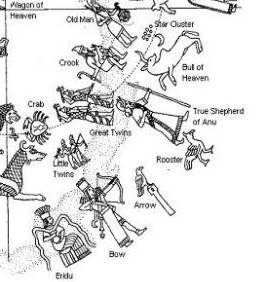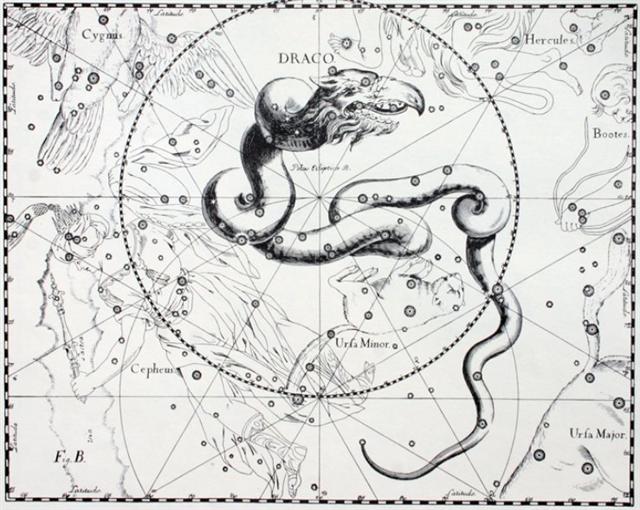The stars were firm points of reference but the Sun was not, because the precession pushed him gradually earlier in the star year. The northern spring equinox (0h) came earlier and earlier. This point in time was determined by the Sun. Autumn equinox should in principle also be determined by the Sun. However, it was doubtful whether the ship of the Sun really moved beyond midsummer - where he gradually would ground to a halt. In Q this was explicit. The time of 'noon' meant a final for Father Light (Jus-piter):
... Midsummer is the flowering season of the oak, which is the tree of endurance and triumph, and like the ash is said to 'court the lightning flash'. Its roots are believed to extend as deep underground as its branches rise in the air - Virgil mentions this - which makes it emblematic of a god whose law runs both in Heaven and in the Underworld ... The month, which takes its name from Juppiter the oak-god, begins on June 10th and ends of July 7th. Midway comes St. John's Day, June 24th, the day on which the oak-king was sacrificially burned alive. The Celtic year was divided into two halves with the second half beginning in July, apparently after a seven-day wake, or funeral feast, in the oak-king's honour ...
Thinking along these lines it seems necessary to look halfway between the equinoxes also in the G text. But what precisely should be the midpoint? There were 185 glyphs to Antares, yet much indicates a later final for the northern summer:
At the time of the Hyades Gate the Gate of the Goat (at Haedus II) was close to the Full Moon in SEPTEMBER 30. This was clearly a more adequate time for the beginning of the northern winter than nakshatra Aldebaran a week earlier - 6 (or 7) months of summer ended here. Counting the length of the year by the Moon (instead of the Sun) the calendar cycle may have been regarded as 13 * 29½ = 383½ nights long and half this is 191¾. Avoiding the fractions the calendar cycle would though rather have contained 384 nights (= 2 * 192). Counting also the empty glyph space at the beginning of side a day 384 / 2 would be the position of Rei in Ga7-22. Haedus II was rising with the Sun in APRIL 1, in day 91 + 365 = 456 (= 19 * 24). The halfway point could possibly have been at day 456 / 2 = 228 (= 19 * 12). This was AUGUST 16 (228). At the opposite side of the sky was 228 - 183 = day 45 (FEBRUARY 14, All Hearts Day). Here Alrisha (the Knot, α Pisces) rose heliacally when Thuban (α Draconis - the ancient star at the Pole) was close to the Full Moon:
Hevelius has put Thuban on the precessional path around the pole:
We can guess an old system with Thuban at the pole included Alrisha at the opposite side of the year. With Haedus II rising 11 days after 0h at the time of the Hyades Gate this old system may have been created around 71 * 11 = 781 years earlier, i.e. about (64 + 11) * 71 = 5325 years before the time of rongorongo. In Roman times Thuban would have risen with the Sun in 'September 22 (equinox) and the Tail of the Polar Dragon was marked by Thuban. (64 + 11 - 27) * 71 = 48 * 71 = 3408 years before Roman times. The Tail would then gradually have glided further ahead in the year and in rongorongo times heliacal Thuban would have reached 'September 22 (265) + 27 = 292 (October 19). According to the stars the Tail of northern summer could still have been at Thuban rather than having shifted to the Tail of Ursa Minor (i.e. to Polaris) - which at that time (and according to my rules) would have been close to the Full Moon in October 16 (289). The arrival date of king Hotu was said to be 'October 15' perhaps because it was dictated by Thuban - i.e. as it had been around the time when the Pope Gregory XIII determined his calendar around 1582 A.D. (4 precessional days earlier than the time of rongogongo): ... The canoes of Ava Rei Pua and of Hotu were seen near the (off-shore) islets. On the fifteenth day of the month of October (tangaroa uri) the canoe of Hotu and the canoe of Ava Rei Pua landed. On the fifteenth day of the month of October (tangaroa uri), Nonoma left the house during the night to urinate outside. At this point Ira called out to Nonoma, 'Look at the canoe!' Nonoma ran, he quickly went to Te Hikinga Heru (a ravine in the side of the crater Rano Kau) and looked around. There he saw the double canoe way out near the (offshore) islets, and the two (hulls of the canoe) were lashed together. Although some living south of the equator may have have shifted their attention from heliacal Thuban marking the Tail of the northern summer to heliacal Antares marking the Heart for the southern summer. This 'Heart' was probably the plumb at the bottom of the astronomer's line of measurement: ... In the inscriptions of Dendera, published by Dümichen, the goddess Hathor is called 'lady of every joy'. For once, Dümichen adds: Literally ... 'the lady of every heart circuit'. This is not to say that the Egyptians had discovered the circulation of the blood. But the determinative sign for 'heart' often figures as the plumb bob at the end of a plumb line coming from a well-known astronomical or surveying device, the merkhet. Evidently, 'heart' is something very specific, as it were the 'center of gravity' ... See Aeg.Wb. 2, pp. 55f. for sign of the heart (ib) as expressing generally 'the middle, the center'. And this may lead in quite another direction. The Arabs preserved a name for Canopus - besides calling the star Kalb at-tai-man ('heart of the south') ... Suhail el-wezn, 'Canopus Ponderosus', the heavy-weighing Canopus, a name promptly declared meaningless by the experts, but which could well have belonged to an archaic system in which Canopus was the weight at the end of the plumb line, as befitted its important position as a heavy star at the South Pole of the 'waters below'. Here is a chain of inferences which might or might not be valid, but it is allowable to test it, and no inference at all would come from the 'lady of every joy'. The line seems to state that Hathor (= Hat Hor, 'House of Horus') 'rules' the revolution of a specific celestial body - whether or not Canopus is alluded to - or, if we can trust the translation 'every', the revolution of all celestial bodies. As concerns the identity of the ruling lady, the greater possibility speaks for Sirius, but Venus cannot be excluded; in Mexico, too, Venus is called 'heart of the earth'. The reader is invited to imagine for himself what many thousands of such pseudo-primitive or poetic interpretations must lead to: a disfigured interpretation of Egyptian intellectual life ... Such a 'heart' could be used for several purposes and why not in order to find the when Antares culminated at midnight? In rongorongo times this happened in day 192 (July 11) = 137 days before its heliacal rising in day 329 (November 25). Day 137 was May 17, which happened to be the day after heliacal Atlas and Alcyone:
|
|||||||||||||||||||||||||||||||||||||||||||||||||||||||||||||||||||||||||||||||||||||||||||||||||||||||||||||||||||||||||||||||||||||||||||||||||||||||||||||||||||||||||||||||||||||||||||||||||||||||||||||||||||||||||||||||||||||||||||||||||||||||||||||||||||||||||||||||||||||||||||||||

















